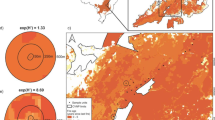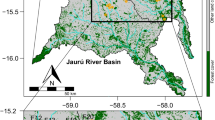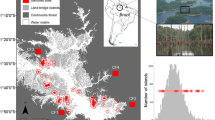Abstract
Fire is a major disturbance event that affects biomes worldwide, altering vegetation structure and flora and fauna assemblages. Here, we investigated the effects of an extensive wildfire (~ 6240 ha) on small mammal assemblages in savanna woodland (cerradão) at two spatial scales (meso- and macrohabitat) in a neotropical savanna (Brazilian Cerrado). At each spatial scale, we assessed relationships between habitat structure and small mammal species composition and abundance before and after the fire in four natural patches (one burned, three unburned) using partial redundancy analysis. From July 2009 to October 2013, we captured 1319 individuals belonging to 14 species. Our results showed that the fire had consequences for small mammal assemblage at both scales. After the fire, the burned patch differed from the other patches in vegetation attributes and species composition. At a fine scale, fire increased the herbaceous layer and decreased the litter layer and understory obstruction. On a larger scale, the main consequences of fire on vegetation structure were increased variation in litter depth, tree diameter, and distance to the nearest tree. We observed a relationship between mesohabitat structure and the abundance of species with different habitat requirements during the post-fire succession. Fire favored the invasion of generalist species from open Cerrado habitats (rodents Calomys tener, Calomys expulsus, Cerradomys scotti, and Necromys lasiurus) at the expense of more specialized forest species. Our results reinforce the relevance of incorporating multi-scale habitat heterogeneity in future studies assessing the effects of fire on wildlife.




Similar content being viewed by others
References
Araújo GM, Nascimento ART, Lopes SF et al (2011) Structure and floristics of the arboreal component of a dystrophic cerradão and comparison with other cerradões in central Brazil. Edinb J Bot 68:401–418
Banks SC, Knight EJ, Mcburney L et al (2011) The effects of wildfire on mortality and resources for an arboreal marsupial: resilience to fire events but susceptibility to fire regime change. PLoS One 6:1–12. https://doi.org/10.1371/journal.pone.0022952
Bonvicino CR, Oliveira JA, D’Andrea PS (2008) Guia dos roedores do Brasil, com chaves para gêneros baseadas em caracteres externos. Centro Pan-Americano de Febre Aftosa - OPAS/OMS, Rio de Janeiro
Borcard D, Legendre P, Avois-Jacquet C, Tuomisto H (2004) Dissecting the spatial structure of ecological data at multiple scales. Ecology 85:1826–1832
Bowman DMJS, Balch JK, Artaxo P, et al (2009) Fire in the earth system. Science (80- ) 324:481–484
Briani DC, Palma ART, Vieira EM, Henriques RPB (2004) Post-fire succession of small mammals in the Cerrado of central Brazil. Biodivers Conserv 13:1023–1037
Bridgewater S, Ratter JA, Ribeiro JF (2004) Biogeographic patterns, β-diversity and dominance in the Cerrado biome of Brazil. Biodivers Conserv 13:2295–2318
Brown BL (2007) Habitat heterogeneity and disturbance influence patterns of community temporal variability in a small temperate stream. Hydrobiologia 586:93–106
Camargo NF, Sano NY, Vieira EM (2018) Forest vertical complexity affects alpha and beta-diversity of small mammals. J Mammal (in press)
Carling PC, Newsome AE, Dudzinski G (1982) Small mammals, habitat components, and fire in Southeastern Australia. 199–206
Cary GJ, Bradstock RA, Gill AM (2012) Global change and fire regimes in Australia. In: Bradstock R, Williams R, Gill AM (eds) Flammable Australia: fire regimes, biodiversity and ecosystems in a changing world. CSIRO Publishing, Collingwood, pp 149–169
Collins SL, Smith MD (2006) Scale-dependent interaction of fire and grazing on community heterogeneity in tallgrass prairie. Ecology 87:2058–2067
Converse SJ, Block WM, White GC (2006) Small mammal population and habitat responses to forest thinning and prescribed fire. For Ecol Manag 228:263–273
Coppeto SA, Kelt DA, Van VDH et al (2006) Habitat associations of small mammals at two spatial scales in the northern Sierra Nevada. J Mammal 87:402–413
Coutinho LM (1990) Fire in the ecology of the brazilian Cerrado. In: Goldammer JG (ed) Fire in the tropical biota. Springer-Verlag, Berlin Heidelberg, pp 82–105
Diffenbaugh NS, Field CB (2013) Changes in ecologically critical terrestrial climate conditions. Science (80- ) 341:486–492
Dornelas M (2010) Disturbance and change in biodiversity. Phil Trans R Soc B 365:3719–3727
Dumbrell AJ, Clark EJ, Frost GA et al (2008) Changes in species diversity following habitat disturbance are dependent on spatial scale: theoretical and empirical evidence. J Appl Ecol 45:1531–1539
Erwin WJ, Stasiak RH (1979) Vertebrate mortality during the burning of a reestablished prairie in Nebraska. Am Midl Nat 101:247–249
Fisher JT, Anholt B, Volpe JP (2011) Body mass explains characteristic scales of habitat selection in terrestrial mammals. Ecol Evol 1:517–528
Fox BJ (1982) Fire and mammalian secondary sucession in an Australian coastal heath. Ecology 63:1332–1341
Freitas SR, Cerqueira R, Vieira MV (2002) A device and standard variables to describe microhabitat structure of small mammals based on plant cover. Braz J Biol 62:795–800
Gardner AL (2008) Mammals of South America, vol. 1: marsupials, xenarthrans, shrews, and bats. University of Chicago Press, Chicago, Illinois
Griffiths AD, Brook BW (2014) Effect of fire on small mammals: a systematic review. Int J Wildland Fire 23(7):1034
Hammer Ø, Harper DAT, Hyan PD (2001) PAST: paleontological statistics software package for education
Henriques RPB, Bizerril MXA, Palma ART (2000) Changes in small mammal populations after fire in a patch of unburned cerrado in Central Brazil. Mammalia 64:173–185
Henriques RPB, Briani DC, Palma ART, Vieira EM (2006) A simple graphical model of small mammal succession after fire in the brazilian Cerrado. Mammalia:226–230
Hoffmann WA (1998) Post-burn reproduction of woody plants in a neotropical savanna: the relativa importance of sexual and vegetative reproduction. J Appl Ecol 35:422–433
Hoffmann WA, Moreira AG (2002) The role of fire in population dynamics of woody plants. In: Oliveira PS, Marquis RJ (eds) The Cerrados of Brazil. Ecology and natural history of a Neotropical savanna. Columbia University Press, New York, pp 159–177
Hoffmann WA, Adasme R, Haridasan M et al (2009) Tree topkill, not mortality, governs the dynamics of savanna-forest boundaries under frequent fire in central Brazil. Ecology 90:1326–1337
Inions GB, Tanton MT, Davey SM (1989) Effect of fire on the availability of hollows in trees used by the common brushtail possum, Trichosurus vulpecula, Kerr, 1782, and the ringtail possum, Pseudocheirus peregrinus, Boddaerts, 1785. Wildl Res 16:449–458
Johnson DH (1980) The comparison of usage and availability measurements for evaluating resource preference. Ecology 61:65–71
Johnson EA, Miyanishi K (2007) Plant disturbance ecology: the process and the response. Elsevier Academic Press
Klink CA, Machado RB (2005) Conservation of the Brazilian Cerrado. Conserv Biol 19:707–713
Klink CA, Moreira AG (2002) Past and current human occupation, and land use. In: Oliveira PS, Marquis RJ (eds) The Cerrados of Brazil: ecology and natural history of a Neotropical savanna. Columbia University Press, New York, pp 69–88
Köppen W (1948) Climatologia: con un estudio de los climas de la Tierra. Fondo Cultura Economica, Mexico city, Mexico
Legendre P, Gallagher E (2001) Ecologically meaningful transformations for ordination of species data. Oecologia 129:271–280
Legendre P, Oksanen J, ter Braaak CJF (2011) Testing the significance of canonical axes in redundancy analysis. Methods Ecol Evol 2:269–277
Lemmon PE (1956) A spherical densiometer for estimating forest overstory density. For Sci 2:314–320
Letnic M, Dickman CR (2005) The responses of small mammals to patches regenerating after fire and rainfall in the Simpson Desert, central Australia. Austral Ecol 30:24–39
Lindenmayer DB, Blanchard W, McBurney L et al (2013) Fire severity and landscape context effects on arboreal marsupials. Biol Conserv 167:137–148
Mares MA, Ernest KA, Gettinger DD (1986) Small mammal community structure and composition in the Cerrado province of central Brazil. J Trop Ecol 2:289–300
Mendonça AF, Armond T, Camargo ACL et al (2015) Effects of an extensive fire on arboreal small mammal populations in a neotropical savanna woodland. J Mammal 96:368–379
Mills JN, Ellis BT, McKee KT et al (1991) Habitat associations and relative densities of rodent populations in cultivated areas of central Argentina. J Mammal 72:470–479
Miranda AC, Miranda HS, Dias I de FO, Dias BF de S (1993) Soil and air temperatures during prescribed cerrado fires in central Brazil. J Trop Ecol 9:313–320
Miranda HS, Bustamante MMC, Miranda AC (2002) The fire factor. In: Oliveira PS, Marquis RJ (eds) The Cerrados of Brazil: ecology and natural history of a Neotropical savanna. Colombia University Press, New York, pp 51–68
Mittermeier RA, Myers N, Thomsen JB et al (1998) Biodiversity hotspots and major tropical wilderness areas: approaches to setting conservation priorities. Conserv Biol 12:516–520
Monamy V, Fox BJ (2000) Small mammal succession is determined by vegetation density rather than time elapsed since disturbance. Austral Ecol 25:580–587
Moreira AG (2000) Effects of fire protection on savanna structure in central Brazil. J Biogeogr 27:1021–1029
Morris DW (1979) Microhabitat utilization and species distribution of sympatric small mammals in southwestern Ontario. Am Midl Nat 101:373–384
Morris DW (1984) Patterns and scale of habitat use in two temperate-zone, small mammal faunas. Can J Zool 62:1540–1547
Morris DW (1987) Ecological scale and habitat use. Ecology 68:362–369
Myers N, Mittermeier RA, Mittermeier CG et al (2000) Biodiversity hotspots for conservation priorities. Nature 403:852–858
Ojeda RA (1989) Small-mammal responses to fire in the Monte desert, Argentina. J Mammal 70:416–420
Paglia AP, Rylands AB, Herrmann G et al (2012) Lista Anotada dos Mamíferos do Brasil/Annotated Checklist of Brazilian Mammals, 2nd edn. Occasional Papers in Conservation Biology, No. 6. Conservation International, Arlington
Penn AM, Sherwin WB, Lunney D, Banks PB (2003) The effects of a low-intensity fire on small mammals and lizards in a logged, burnt forest. Wildl Res 30:477–486
Picket STA, White PS (1985) The ecology of natural disturbance and patch dynamics. Academic Press Inc
Pitman AJ, Narisma GT, Mcaneney J (2007) The impact of climate change on the risk of forest and grassland fires in Australia. Clim Chang 84:383–401
Price B, Kutt AS, Mcalpine CA (2010) The importance of fine-scale savanna heterogeneity for reptiles and small mammals. Biol Conserv 143:2504–2513
Ratter JA, Ribeiro JF, Bridgewater S (1997) The Brazilian Cerrado vegetation and threats to its biodiversity. Ann Bot 80:223–230
Recher HF, Lunney D, Matthews A (2009) Small mammal populations in a eucalypt forest affected by fire and drought . I. Long-term patterns in an era of climate change. Wildl Res 36:143–158
Ribeiro J, Walter B (1998) Fitofisionomias do Cerrado. In: Sano S, Almeida S (eds) Cerrado: ambiente e flora. EMBRAPA-CPAC, Brazil, pp 87–166
Roberts SL, Kelt DA, Van Wagtendonk JW et al (2015) Effects of fire on small mammal communities in frequent-fire forests in California. J Mammal 96:107–119
Robinson NM, Leonard SWJ, Ritchie EG et al (2013) Refuges for fauna in fire-prone landscapes: their ecological function and importance. J Appl Ecol 50:1321–1329
Rogers P (1996) Disturbance ecology and forest management: a review of the literature. USDA, Forest Service, Intermountain Research Station, Ogden. Gen Tech Report INT-336
Schwilk DW, Keeley JE (1998) Rodent populations after a large wildfire in California chaparral and coastal sage scrub. Southwest Nat 43:480–483
Sikes RS, Ganon WL, Animal Care and Use Committee of the American Society of Mammalogists (2011) Guidelines of the American Society of Mammalogists for the use of wild mammals in research. J Mammal 92:235–253
Simonetti JA (1989) Microhabitat use by small mammals in central Chile. Oikos 56:309–318
Simons LH (1991) Rodent dynamics in relation to fire in the Sonoran desert. J Mammal 72:518–524
Sousa WP (1984) The role of disturbance in natural communities. Annu Rev Ecol Syst 15:353–391
Sutherland EF, Dickman CR (1999) Mechanisms of recovery after fire by rodents in the Australian environment: a review. Wildl Res 26:405–419
Sutherland WJ, Freckleton RP, Godfray HCJ et al (2013) Identification of 100 fundamental ecological questions. J Ecol 101:58–67
Swan M, Christie F, Sitters H et al (2015) Predicting faunal fire responses in heterogeneous landscapes: the role of habitat structure. Ecol Appl 25:2293–2305
Team RC (2018) R: a language and environment for statistical computing
Tews J, Brose U, Grimm V et al (2004) Animal species diversity driven by habitat heterogeneity/diversity: the importance of keystone structures. J Biogeogr 31:79–92
Vieira EM (1999) Small mammal communities and fire in the Brazilian Cerrado. J Zool 249:75–81
Vieira EM, Briani DC (2013) Short-term effects of fire on small rodents in the Brazilian Cerrado and their relation with feeding habits. Int J Wildl Fire
Vieira EM, Marinho-Filho J (1998) Pre- and post-fire habitat utilization by rodents of Cerrado from central Brazil. Biotropica 30:491–496
Vieira EM, Iob G, Briani DC, Palma ART (2005) Microhabitat selection and daily movements of two rodents (Necromys lasiurus and Oryzomys scotti) in Brazilian Cerrado , as revealed by a spool-and-line device. Mamm Biol 70:359–365
Vieira EM, Baumgarten LC, Paise G, Becker RG (2010) Seasonal patterns and influence of temperature on the daily activity of the diurnal neotropical rodent Necromys lasiurus. Can J Zool 88:259–265
Whelan RJ (1995) Approaches to population studies. In: The ecology of fire. Cambridge University Press, Cambridge, pp 135–150
Williams SE, Marsh H, Winter J (2002) Spatial scale, species diversity, and habitat structure: small mammals in Australian tropical rain forest. Ecology 83:1317–1329
Zar JH (1999) Bioestatistical analysis. Prentice Hall New Jersey, New Jersey
Acknowledgments
We thank the Coordenação de Aperfeiçoamento de Pessoal de Nível Superior (CAPES, Coordination for the Improvement of Higher Education Personnel) for the master scholarship (ACLC) and postdoctorate scholarship (AFM) provided. We gratefully acknowledge the permission granted by the Botanical Garden of Brasília (Jardim Botânico de Brasília [JBB]) and the Ecological and Agricultural Field Station of the University of Brasília (Fazenda Água Limpa [FAL/UnB]) to carry out our study. We are also grateful to several colleagues for their help in the fieldwork.
Funding
This work was supported by the Brazilian Conselho Nacional de Pesquisa (CNPq, National Research Council: research productivity grant to EMV no. 308992/2013-0, research funding grant no. 483117/2009-9, and Long-term Ecological Research Program [PELD/CNPq] grant no. 403845/2012-2).
Author information
Authors and Affiliations
Corresponding author
Electronic supplementary material
Rights and permissions
About this article
Cite this article
Camargo, A.C.L., Barrio, R.O.L., de Camargo, N.F. et al. Fire affects the occurrence of small mammals at distinct spatial scales in a neotropical savanna. Eur J Wildl Res 64, 63 (2018). https://doi.org/10.1007/s10344-018-1224-8
Received:
Revised:
Accepted:
Published:
DOI: https://doi.org/10.1007/s10344-018-1224-8




